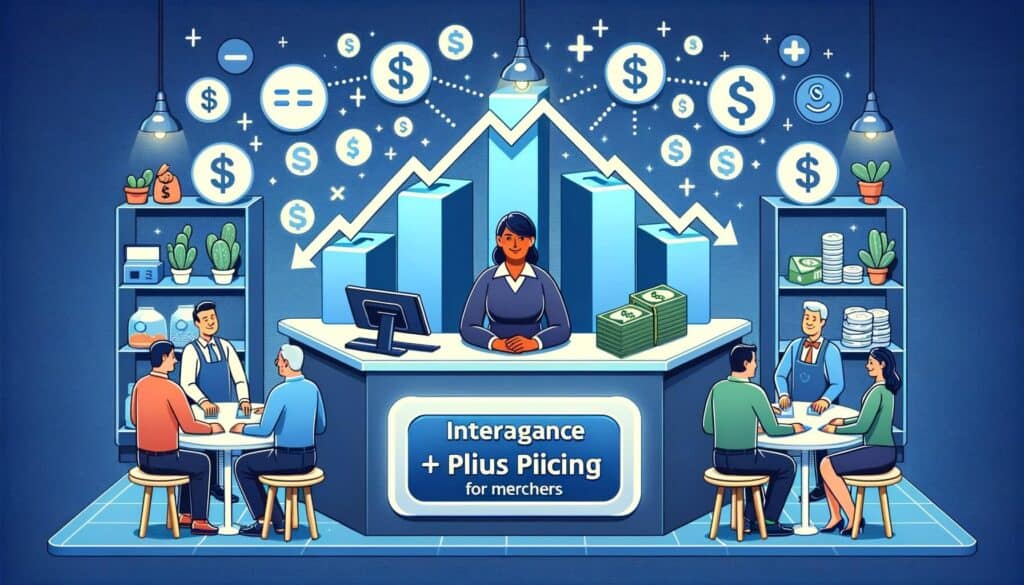
By Carol Peters December 27, 2024
Interchange Plus Pricing is a transparent and cost-effective pricing model used in the payment processing industry. It is a method of pricing that separates the interchange fees charged by card networks from the markup fees charged by payment processors. This pricing structure has gained popularity among merchants due to its simplicity and fairness.
In this article, we will delve into the intricacies of Interchange Plus Pricing, its components, advantages, disadvantages, and how it differs from tiered pricing.
Understanding the Basics of Interchange Plus Pricing
Interchange Plus Pricing is a pricing model that breaks down the costs associated with accepting credit and debit card payments. It consists of two main components: interchange fees and the processor’s markup. Interchange fees are set by the card networks, such as Visa and Mastercard, and are non-negotiable. They are determined based on various factors, including the type of card used, the transaction volume, and the risk associated with the transaction.
The processor’s markup, on the other hand, is the fee charged by the payment processor for their services. This markup is negotiable and can vary from one processor to another. With Interchange Plus Pricing, the processor’s markup is added on top of the interchange fees, resulting in a transparent and itemized pricing structure.
The Components of Interchange Plus Pricing

Interchange Plus Pricing consists of two main components: interchange fees and the processor’s markup. Interchange fees are the fees charged by the card networks for processing transactions. These fees are determined based on various factors, including the type of card used, the transaction volume, and the risk associated with the transaction. Interchange fees are non-negotiable and are the same for all payment processors.
The processor’s markup, on the other hand, is the fee charged by the payment processor for their services. This markup is negotiable and can vary from one processor to another. It is typically expressed as a percentage of the transaction amount or as a flat fee per transaction. The processor’s markup covers the costs of providing payment processing services, including customer support, fraud prevention, and technology infrastructure.
Advantages of Interchange Plus Pricing for Merchants

Interchange Plus Pricing offers several advantages for merchants. Firstly, it provides transparency in pricing, allowing merchants to see the exact interchange fees and markup charged for each transaction. This transparency helps merchants understand the true cost of accepting card payments and enables them to compare pricing across different payment processors.
Secondly, Interchange Plus Pricing is often more cost-effective for merchants, especially those with high transaction volumes or those processing high-value transactions. Since interchange fees are non-negotiable and the same for all payment processors, merchants can focus on negotiating the processor’s markup. By choosing a payment processor with a competitive markup, merchants can save significantly on their payment processing costs.
Additionally, Interchange Plus Pricing allows merchants to have more control over their pricing structure. They can choose to pass on the interchange fees directly to the customer or absorb them as part of their overall pricing strategy. This flexibility gives merchants the ability to optimize their pricing and maximize their profit margins.
Disadvantages of Interchange Plus Pricing for Merchants

While Interchange Plus Pricing offers many advantages, it also has some disadvantages for merchants. One of the main disadvantages is the complexity of understanding and comparing pricing across different payment processors. Since interchange fees and markups can vary, merchants need to carefully analyze and compare pricing proposals to ensure they are getting the best deal.
Another disadvantage is the potential for hidden fees or additional charges. While interchange fees and markups are transparent, some payment processors may add additional fees for services such as PCI compliance, chargebacks, or statement fees. Merchants need to carefully review the terms and conditions of their agreement to avoid any unexpected costs.
Furthermore, Interchange Plus Pricing may not be suitable for all types of businesses. Smaller merchants with low transaction volumes may find that the fixed costs associated with Interchange Plus Pricing are higher compared to other pricing models, such as tiered pricing. It is important for merchants to assess their specific business needs and transaction volumes before deciding on the pricing model that best suits them.
How Interchange Plus Pricing Works: A Step-by-Step Guide
To understand how Interchange Plus Pricing works, let’s walk through a step-by-step guide:
Step 1: A customer makes a purchase using a credit card at a merchant’s store or website.
Step 2: The payment processor sends the transaction details to the card network, such as Visa or Mastercard.
Step 3: The card network checks the transaction details and determines the interchange fee based on factors like the type of card used and the risk associated with the transaction.
Step 4: The card network deducts the interchange fee from the transaction amount and sends the remaining amount to the payment processor.
Step 5: The payment processor adds its markup fee to the remaining amount and deposits the final amount into the merchant’s account.
Step 6: The merchant can view the breakdown of the interchange fee and the markup fee in their payment processing statement.
How Interchange Plus Pricing Differs from Tiered Pricing

Interchange Plus Pricing differs from tiered pricing in several ways. Tiered pricing is a pricing model that groups transactions into different tiers or categories based on their risk level. Each tier has a predetermined rate, which includes both interchange fees and the processor’s markup. This pricing model is often less transparent and can result in higher costs for merchants.
In contrast, Interchange Plus Pricing separates interchange fees from the processor’s markup, providing a more transparent and itemized pricing structure. With Interchange Plus Pricing, merchants can see the exact interchange fees and markup charged for each transaction, allowing for better cost analysis and comparison.
Another difference between Interchange Plus Pricing and tiered pricing is the level of flexibility and control over pricing. With Interchange Plus Pricing, merchants have the ability to pass on the interchange fees directly to the customer or absorb them as part of their overall pricing strategy. This flexibility allows merchants to optimize their pricing and adapt to market conditions.
Factors to Consider When Choosing Interchange Plus Pricing
When choosing Interchange Plus Pricing, there are several factors that merchants should consider. Firstly, it is important to assess the specific needs of the business, including transaction volumes, average transaction values, and the types of cards accepted. This information will help merchants determine the potential cost savings and benefits of Interchange Plus Pricing.
Secondly, merchants should carefully review and compare pricing proposals from different payment processors. It is important to understand the interchange fees and markups charged by each processor and assess their competitiveness in the market. Merchants should also consider the additional services and features offered by each processor, such as customer support, fraud prevention, and reporting capabilities.
Furthermore, merchants should consider the reputation and reliability of the payment processor. It is important to choose a processor with a proven track record of providing secure and reliable payment processing services. Merchants should also consider the processor’s level of customer support and their ability to handle any issues or disputes that may arise.
Comparing Interchange Plus Pricing with Other Payment Processing Models
Interchange Plus Pricing is often compared to other payment processing models, such as flat-rate pricing and tiered pricing. Let’s compare these models to understand the differences:
Flat-rate pricing charges a fixed percentage fee for all transactions, regardless of the interchange fees. While this model offers simplicity, it may not be cost-effective for businesses with high transaction volumes or those that process transactions with varying interchange fees.
Tiered pricing categorizes transactions into different tiers based on their interchange fees. Each tier has a fixed percentage fee, which may vary depending on the payment processor. While this model offers simplicity, it lacks transparency as merchants cannot see the exact interchange fee charged for each transaction.
In comparison, Interchange Plus Pricing offers transparency and cost-effectiveness. Merchants can see the exact interchange fee charged for each transaction and pay a fixed markup fee. This pricing model is suitable for businesses with high transaction volumes or those that process transactions with varying interchange fees.
Common Misconceptions about Interchange Plus Pricing
There are several misconceptions about Interchange Plus Pricing that need to be addressed. One common misconception is that Interchange Plus Pricing is only suitable for large businesses. In reality, businesses of all sizes can benefit from this pricing model. Small businesses can also negotiate competitive markup fees with payment processors.
Another misconception is that Interchange Plus Pricing is complicated and difficult to understand. While the payment processing industry can be complex, Interchange Plus Pricing offers transparency and simplicity. Merchants can easily see the breakdown of the interchange fees and markup fees in their payment processing statements.
Frequently Asked Questions about Interchange Plus Pricing
Q1. What is the difference between interchange fees and the processor’s markup?
Interchange fees are set by the card networks and are non-negotiable, while the processor’s markup is the fee charged by the payment processor for their services and is negotiable.
Q2. How can Interchange Plus Pricing benefit merchants?
Interchange Plus Pricing offers transparency, cost-effectiveness, and flexibility for merchants, allowing them to understand the true cost of accepting card payments, save on payment processing costs, and optimize their pricing strategy.
Q3. Are there any hidden fees or additional charges with Interchange Plus Pricing?
While interchange fees and markups are transparent, some payment processors may add additional fees for services such as PCI compliance, chargebacks, or statement fees. Merchants should carefully review the terms and conditions of their agreement to avoid any unexpected costs.
Q4. Is Interchange Plus Pricing suitable for all types of businesses?
Interchange Plus Pricing may not be suitable for all types of businesses, especially smaller merchants with low transaction volumes. It is important for merchants to assess their specific business needs and transaction volumes before deciding on the pricing model that best suits them.
Conclusion
Interchange Plus Pricing is a transparent and cost-effective pricing model that separates interchange fees from the processor’s markup. It offers several advantages for merchants, including transparency, cost-effectiveness, and flexibility. However, it also has some disadvantages, such as complexity and potential hidden fees.
When choosing Interchange Plus Pricing, merchants should consider factors such as their specific business needs, pricing proposals from different payment processors, and the reputation and reliability of the processor. By carefully assessing these factors, merchants can make an informed decision and benefit from the advantages of Interchange Plus Pricing.
